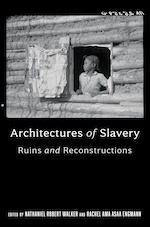Today, we are happy to bring you our conversation with Nathaniel Walker and Rachel Ama Asaa Engmann, editors of Architectures of Slavery: Ruins and Reconstructions
What inspired you to write this book?
This book originated from a scholarly conference of the same name organized at the College of Charleston in 2019. Inspired by the activity picking up pace in that city, including the rise of the International African American Museum, the conference proved intellectually generative. Some speakers and a few other scholars and artists stepped forward to produce a collected volume, and one of the participants, Rachel Ama Asaa Engmann, was invited to serve as a coeditor. The project slowed but also gathered force and clarity during the following five years, which brought an international reckoning following the police murder of George Floyd. These events prompted many contributors to re-examine the legacies of their historical research. What had once been framed primarily as an exploration of the past evolved into a more urgent inquiry into how these histories resonate in the present — refracted through new theoretical frameworks and a heightened awareness of structural injustice. The essays in this volume reflect substantial revisions and expansions beyond the versions delivered at the conference.
What did you learn and what are you hoping readers will learn from your book?
Rachel: Negotiating how to write about the history of architecture and enslavement — and its afterlives — was a continuous learning process. It required us, as contributors and editors, to learn how to hear and how to truly listen; how to navigate tensions, resolve differences where possible, and accept moments of unresolved complexity. We can learn from a position of discomfort.
Nathaniel: I was struck by how near the histories of slavery and segregation are to the most formative years of many communities in the Atlantic World. Without the economic structures of slavery and their socio-political instrument of racism, our towns and cities would look and function very differently than they do now, and they would be much better. Suburban dispersal and urban disinvestment, for example, would not have had the force that they did without the echoes of slavery howling them on. We would have cared better for our shared spaces if we had done a better job of caring for each other.
What surprised you the most in the process of writing your book?
Rachel: As a critical heritage “person,” I was struck by the ways in which architectural history theorizes and engages with the topic of enslavement, and how it is quite different from current approaches within the field of archaeology. The questions posed, the frameworks employed, and even the scales of analysis reveal distinct disciplinary lenses — offering both challenges and opportunities for interdisciplinary dialogue.
Nathaniel: It was both overwhelming and encouraging to come to deeply appreciate how the United States is not unique in its struggles with the afterlives of slavery. Cuba, Brazil, Barbados, Antigua and Barbuda — everywhere that was shaped by slavery has been pulled into this story, and their architecture, urbanism, and landscapes bear the scars. This makes the scale of the problem stunning, disorienting, and disheartening — but it also means that we have a lot in common with our neighbors. A family of nations has been forged in this crucible. We can and should claim the precious and empowering sense of unity of purpose that this offers.
What’s your favorite anecdote from your book?
Rachel: I am not sure that I have one — each chapter offers something distinct and meaningful. The book brings together so many voices, experiences, and layers of history that it’s hard to choose just one.
Nathaniel: Yes, this is a hard book in which to seek “favorites,” but there are some highlights for me. The audacious courage of Juana Agrippina in dragging her own chains before a court of law in Ponce is mighty to behold. I was also inspired to see the U.S. President Theodore Roosevelt, whose record is not spotless, defying the racist mayor of Charleston to defend Black federal officer William Demos Crum. The story of Richmond’s Maggie L. Walker also offers a marvelous tale of Black achievement in the face of hardship, with an eloquent legacy of fine architecture.
What’s next?
Rachel: My heritage work at Christiansborg Castle will continue as a community-engaged endeavor (www.christiansborgarchaeologicalheritageproject.org). Looking ahead, I am committed to further exploring and experimenting with innovative ways of conducting research, fieldwork and writing that bridges the gap between academia and the larger public. My goal is to ensure that the work we do remains relevant, accessible, and meaningful to as many people as possible.
Nathaniel: I am presently researching a lost golden age of roof gardens in the United States and beyond. In the late 1700s, 1800s, and early 1900s, we developed a veritable roof garden culture with many rich entanglements, hosting and animating debates about the ideal relationships between the urban and the rural, labor and capital, the East and the West, men and women, etc. I have a couple of essays coming out “soonishly” and then I will produce a book. As in Architectures of Slavery, I hope that my next project will shine new light on how, in the words of the brilliant Clifton Ellis, architecture acts as a determining force in human relationships.




